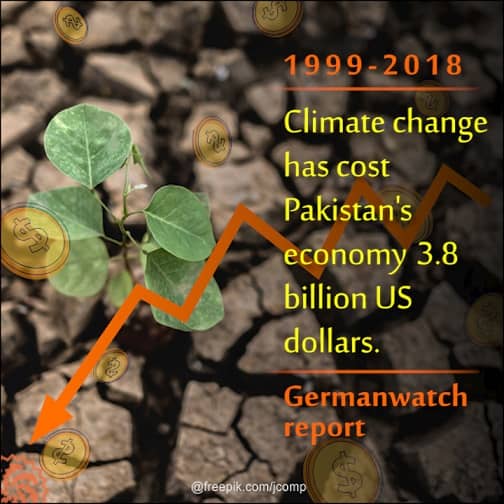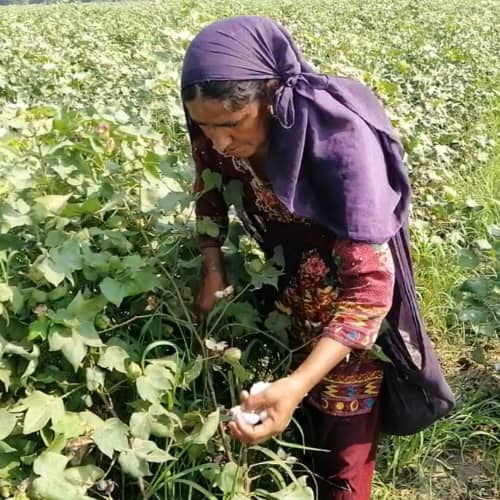Pakistan’s average temperature has registered an increase of one degree centigrade since the birth of the country. At the same time, local precipitation pattern has recorded a 20 per cent change, resulting in large scale changes in the frequency, intensity and locale of rain. These variations together have disturbed the usual start and end of the seasons in some areas while other parts of the country are experiencing sharp turns in weather.
This was revealed in a report recently released by the Global Impact Change Study Centre, a government-run research institution based in Islamabad. It also stated that the duration of summer season has been increasing by one day every year over the last decade.
Germanwatch, an international think-tank based in Germany, has listed Pakistan in its annual report of 2020 among top five countries most affected by climate change. The report estimates that Pakistan suffered an economic loss of three billion US dollars between 1999 and 2018 due to changes in climate. In addition, as many as 9,989 Pakistanis have fallen prey to heatwaves and torrential rains during the same period while an adverse effect on the country’s agriculture sector has also been noticeable in these years.
Similarly, a report released by the Asian Development Bank in May this year points out that increase in temperature and humidity in Pakistan are badly affecting a number of crops, including cotton.
Official statistics lend credence to this report.

As per the government data, Punjab province — which grows 65 per cent to 70 per cent of all the cotton produced in Pakistan – harvested 8.84 million bales, each containing 370 kilograms of cotton, in 1999 but its production declined to 5.44 million bales in 2020-2021. This means that cotton production in the province has decreased by 43 per cent during this period. The crop’s country-wide production, meanwhile, has gone down by 39 per cent.
Additionally, per acre yield of cotton has decreased by 24 per cent in these years. It was 836 kilograms in 1999 but was reduced to 633 kilograms in 2020.
Cotton grower in Punjab, too, are well-aware of the fact that climate change is having a devastating effect on their crop.
Liaquat Ali Chattha, who hails from Punjab’s Vehari district famed for its massive cotton production, says frequent changes in temperature and humidity, coupled with an increase in heavy precipitation, have led to a rise in pest attacks on cotton crop in recent years. Consequently, he says, its per acre yield has been decreasing constantly.
“This is why,” he says, “local farmers are more inclined towards cultivating corn, rice and sugarcane than cotton, leading to a reduction in area under its cultivation by 45 per cent as compared to 1999.”
Dr Azra Talat Sayeed, an economist and an expert on issues relating to seeds, also declares climate change as one of the major reasons behind reduction in Pakistan’s cotton production. Rains are extremely harmful for cotton crop when it starts blossoming in May and June, she says, but there have been frequent rains during these months over the last few years. This has increased the number of pests attacking the crop while flies that play a pivotal role in its pollination have shifted elsewhere, causing a “reduction in cotton production.”
Both Sayeed and Chattha complain that the government-run research centres in Pakistan have failed to introduce seeds which can brave such environmental and climatic hazards.
The nuclear option
On September 23 this year, International Atomic Energy Agency (IAEA) conferred an award on five Pakistani scientists working at the Nuclear Institute of Agriculture and Biology (NIAB) for introducing a new variety of cotton seed. IAEA Director General Rafael Mariano Grossi stated in one of his tweets that day: “Impressive to see how quickly Pakistan’s scientists were able to produce climate resilient strains of cotton — an inspiring example of the peaceful application of nuclear science benefiting society.”

NIAB Director Tariq Mahmud Shah says the new variety of cotton seed was produced by applying atomic rays on an indigenous seed. This process not only enlarged the seed but also increased its resistance to tough weather, he says.
It is, however, not the first time that NIAB has introduced a weather-resisting seed, he says. Its scientists, according to him, have produced a number of seeds which can fight climate change. This year alone, he claims, 50 per cent of cotton seeds provided to farmers through various government departments were produced by NIAB. “From among them, NIAB-878 is a variety which can ensure a bumper crop -- subject to the government’s ability to provide it on a reasonable price to the maximum number of farmers.”
But the fact is that the government-provided seeds are sown only on 3 per cent of the total land under cotton cultivation. The NIAB director partially agrees with this. He says the seeds produced and certified by the government are sown on 18 per cent to 20 per cent of the farmland where cotton is sown. Uncertified seeds produced by private sector, on the other hand, are used in the remaining 80 per cent area.
Also Read

Corporate profit vs farmers' plight: Why DAP fertilizer price has risen sharply over the last one year
But as Dr Idrees Ahmed, a professor at Punjab University’s Centre of Excellence in Microbiology, puts it, even if all the cotton farmers across Pakistan start cultivating NIAB-produced seeds, it will not make a big difference in the crop’s yield. This is because, he argues, the use of nuclear technology can strengthen a seed’s resistance against weather but it cannot give it protection against pests, bollworms and whiteflies.
The trial cultivation of NIAB seeds in 2020 endorses his point of view. A recently-released report by the Punjab Seed Corporation, a subsidiary of the Punjab Agriculture Department, states that NIAB seeds were among 30 varieties -- produced both by the government and private companies -- which were cultivated in Pirowal area of Khenewal district on trial basis. Out of these, 17 were approved for cultivation: only three of them were produced by NIAB.
So far as their production is concerned, NIAB-135 clinched second position with 735 kilograms per acre yield. Nonetheless, it was not approved for cultivation due to its technical flaws. The three NIAB varieties which succeeded in being approved were on seventh, 10th and 26th position in terms of per acre production. Out of these, NIAB-SANAB-M has a yield of 530 kilograms per acre; NIAB-512 and NIAB-989 respectively produced a per acre yield of 494 kilograms and 313 kilograms.
On the other hand, the cotton seed used most extensively in Pakistan has an average per acre yield of 638 kilograms.
Weather permitting
A report released in April 2021 by the United States Department of Agriculture predicts an 18 per cent increase in Pakistan’s cotton production this year. This, according to the report, is because Pakistani government has made “the process of seeds approval easy and faster” as compared to the previous years.
Cotton growers acknowledge that the production has registered an increase but they believe that it is not because of the seed availability but rather due to favourable weather.

Muhammad Aslam Raza, a farmer from Dunyapur area in southern Punjab’s Lodhran district, cultivated the same seeds this year that he had been using for the last many years but this time around his per acre yield registered a three-fold increase.
This year, he says, there were no pre-monsoon rains and the level of humidity was not that high. This is why whiteflies and pests could not harm the crop, he adds. In the past, according to him, cotton flowers and cotton balls would also wilt and fall off the plants due to constantly high temperature but no such thing was noticed this year.
Chattha has a similar opinion.
He used the same variety of cotton seeds this year which he had been cultivating for the last many years but he sowed his crop at the end of February rather than in April. This helped him protect his crop both from pre-monsoon rains and scorching heat. Consequently, his per acre yield this year was nearly 2,000 kilograms -- four times more than his average per acre yield in the last three years.
Published on 9 Oct 2021




















